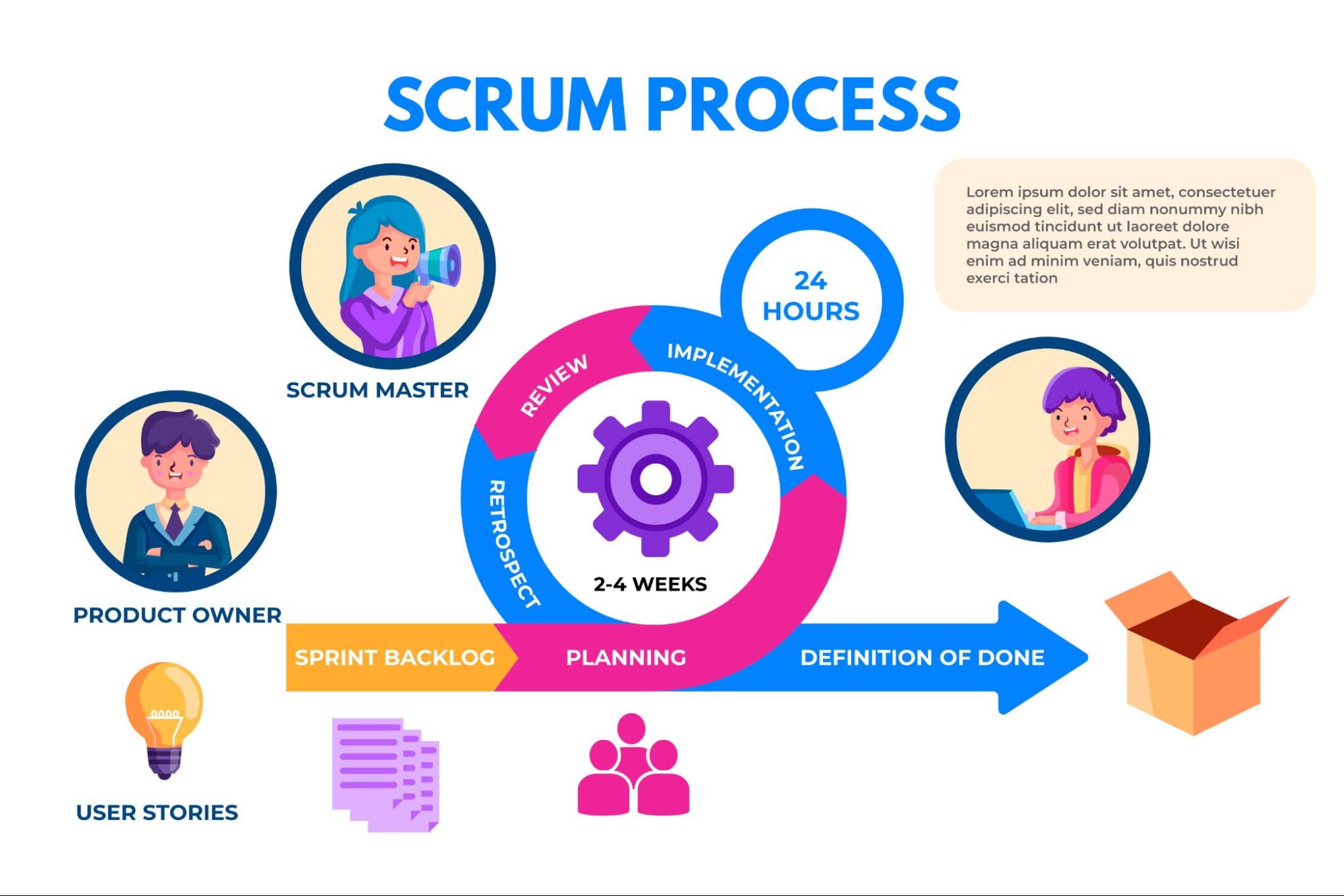A Complete Agile Methodology Scrum Guide 101
Dive into the agile methodology with our comprehensive Scrum guide. Learn about Scrum principles, roles, artifacts, and ceremonies.
Start Free Trial
Dive into the agile methodology with our comprehensive Scrum guide. Learn about Scrum principles, roles, artifacts, and ceremonies.
Start Free Trial
Scrum is an agile project management framework designed to help teams structure and manage their work through a set of values, principles, and practices. Named after the rugby formation, scrum emphasises teamwork, learning through experiences, self-organization, and continuous improvement. Though it originated in software development, scrum's principles are versatile and applicable to various types of teamwork, contributing to its widespread popularity.
At its core, Scrum is an agile framework that consists of specific meetings, tools, and roles working together to facilitate team collaboration and efficiency. This structure encourages teams to plan, execute, and review their work in iterative cycles, enhancing productivity and adaptability. The Scrum guides the framework defines Guide, which provides a comprehensive overview of its components and their interactions. However, teams often adapt these fundamentals to suit their unique needs and challenges better.

While agile and scrum defines are closely related, they are not the same. Agile methodology scrum is a broader philosophy centred on continuous incremental improvement through small, frequent releases. It represents a mindset and cultural shift towards delivering consistent value to customers. Scrum, on the other hand, is a specific framework for implementing agile principles. It provides a structured approach to adopting agile practices, enabling teams to integrate these principles into their daily routines and communication gradually.
The Agile Manifesto and the Scrum guide provide valuable insights into the differences between Agile and the definition of Scrum. The Agile manifesto emphasises four core values:
Scrum is grounded in empiricism and lean thinking. Empiricism asserts that knowledge comes from experience and decisions are made based on what is observed. Lean thinking aims to reduce waste and focus on what is essential. The scrum framework is heuristic, promoting continuous learning and adaptation to evolving factors. It acknowledges that teams don’t have all the answers at the beginning and will evolve through experience. Scrum is designed to help teams adapt to changing conditions and user requirements, incorporating re-prioritization and short-release cycles for ongoing improvement.
Although scrum is structured, it remains flexible and can be tailored to suit any organization’s needs. There are various theories on how scrum teams should operate for success. However, after years of supporting agile teams at Atlassian, we've found that clear communication, transparency, and a commitment to continuous improvement are crucial. The specifics of implementation are up to each team.
The agile methodology scrum framework outlines a structured set of values, principles, and practices designed to help teams deliver a product or service efficiently. It defines the roles within a scrum team, the "artifacts" that outline the product and its development work, and the ceremonies that guide the team’s workflow.
A Scrum team is a small, agile group dedicated to delivering incremental product improvements. Typically composed of around 10 members, the team is large enough to handle significant work within a sprint but small enough to remain nimble. The team consists of three key roles: product owner, scrum master, and the development team. Due to its cross-functional nature, the development team includes testers, designers, UX specialists, ops engineers, and developers.
Product owners are the advocates for their products, focusing on understanding business, customer, and market needs and prioritizing work for the engineering team. Effective product owners:
While the product owner may not always be the product manager, their primary focus is to ensure the development team maximizes value delivery. It’s crucial that the product owner be a single individual to avoid mixed guidance, which can hinder the team's effectiveness.
Scrum masters advocate Scrum within their teams, coaching team members, product owners, and the business on Scrum practices and continuously seeking ways to enhance these practices. An effective Scrum master has a deep understanding of the team's work and helps optimize transparency and delivery flow. As the chief facilitator, they organize resources for sprint planning, daily stand-ups, sprint reviews, and retrospectives.

Scrum teams excel at getting things done and champion sustainable development practices. The most effective Scrum teams are tight-knit, co-located, and typically consist of five to seven members. Jeff Bezos' famous ‘two pizza rule’ suggests the team should be small enough to be fed by two pizzas.
Team members possess diverse skill sets and cross-train each other to prevent bottlenecks. Strong Scrum teams are self-organizing and adopt a collaborative ‘we’ attitude, with all members supporting one another to ensure successful sprint completion.
The agile methodology Scrum team determines the plan for each sprint, forecasting the amount of work they can complete based on historical velocity. Consistent iteration length provides valuable feedback on estimation and delivery processes, improving forecast accuracy over time.
Scrum artifacts are crucial pieces of information that help the Scrum team define the product and outline the work needed to create it. The three primary artifacts in Scrum are the product backlog, the sprint backlog, and the increment with your definition of “done.” These artifacts remain constant and are regularly reflected upon during sprints and over time.
The product backlog is the primary list of work that needs to be done, maintained by the product owner or product manager. This dynamic list includes features, requirements, enhancements, and fixes that feed into the sprint backlog. Essentially, it’s the team’s “To Do” list. The product backlog is constantly revisited, re-prioritized, and updated by the product owner as new information is learned or as market conditions change, rendering some items irrelevant or solving problems in other ways.
The sprint backlog consists of items, user stories, or bug fixes selected by the development team for implementation during the current sprint cycle. During the sprint planning meeting, the team chooses which items from the product backlog to work on for the sprint. While the sprint backlog can evolve during the sprint, the primary sprint goal—what the team aims to achieve—remains unchanged.
The increment is the usable end-product from a sprint. At Atlassian, this is often demonstrated during the end-of-sprint demo, where the team showcases what was completed. The term “increment” may not be widely used; it’s often referred to as the team’s definition of “done,” a milestone, the sprint goal, or even a full version or shipped epic. The definition of “done” can vary based on the team’s sprint goals. For instance, some teams might release a product increment to customers at the end of every sprint, making their definition of “done” synonymous with “shipped.” However, this approach may not be practical for all teams, such as those working on server-based products with quarterly release cycles. These teams might still work in two-week sprints, but their definition of “done” might involve completing parts of a larger version planned for a consolidated release. The longer the release cycle, the higher the risk of the software missing its mark.
Given the variations within these artifacts, it’s essential to remain flexible and open to evolving how you maintain them. If your current definition of “done” is causing undue stress, it might be time to reconsider and redefine it.

The Scrum defines framework includes regular practices, ceremonies, and meetings that help teams stay aligned and productive. These Agile ceremonies can vary in their execution based on the team's needs and preferences. To find what works best for your team, it’s recommended to start by practising all ceremonies for two sprints, then assess and adjust as needed. Here are the key ceremonies a Scrum team might partake in:
Also known as backlog grooming, this event is led by the product owner, whose primary responsibilities include driving the product towards its vision and keeping a close pulse on the market and customer needs. The product owner maintains and prioritizes the backlog using feedback from users and the development team, ensuring it’s always ready to be worked on.
Sprint planning is where the development team, guided by the Scrum Master, plans the work to be done in the upcoming sprint. The team sets the sprint goal and selects user stories from the product backlog that align with this goal. At the end of this meeting, every team member should clearly understand what can be delivered in the sprint and how the increment will be achieved
A sprint is the time period during which the Scrum team works together to complete an increment. The typical length for a sprint is two weeks, though some teams may prefer one week or one month, depending on their needs. According to Dave West from Scrum.org, shorter sprints are advisable for more complex work with many unknowns. The scope of work can be renegotiated between the product owner and the development team if necessary, embodying the empirical nature of Scrum.
Each of these ceremonies plays a crucial role in maintaining the rhythm and productivity of the Scrum team, fostering continuous improvement and adaptability.
All the events, from planning to retrospective, occur within the sprint. Once a sprint duration is defined, it should stay consistent throughout the development cycle. This consistency enables the team to learn from previous experiences and apply those insights to improve future sprints.
The daily scrum is a brief, time-boxed meeting that typically occurs in the morning at the same place and time every day to maintain consistency. This meeting, also known as the ‘daily stand-up’, is intended to be quick—usually around 15 minutes. The goal is to ensure that everyone on the team is aligned with the sprint goal and to plan the next 24 hours of work.
During the stand-up, team members address three key questions:
The purpose is to identify any blockers and ensure everyone is on the same page. However, it's important to avoid turning this meeting into a monotonous calendar read-out. Instead, focus on keeping it dynamic and relevant to the sprint goal.
At the end of each sprint, the team holds an informal sprint review session. This meeting is an opportunity for the development team to demonstrate the increment of work completed during the sprint. They showcase the 'Done' backlog items to stakeholders and teammates, gathering feedback and insights
The product owner then decides whether to release the increment. This session also allows the product owner to update the product backlog based on the current sprint’s outcomes, feeding into the next sprint planning session. For a one-month sprint, it’s recommended to time-box the sprint review to a maximum of four hours.
Following the sprint review, the team conducts a sprint retrospective. This meeting is a chance for the team to reflect on what worked well, what didn’t, and how processes can be improved. The focus is on fostering a culture of continuous improvement rather than assigning blame.
During the retrospective, the team discusses:
By regularly holding retrospectives, the team can refine their practices, improve collaboration, and enhance overall productivity.
Each of these ceremonies is crucial for maintaining the momentum and effectiveness of the Scrum framework. They ensure clear communication, foster a collaborative environment, and drive continuous improvement, enabling the team to adapt to changing conditions and deliver high-quality products.
In 2016, five core values were officially added to the Scrum Guide. These values—commitment, Courage, Focus, Openness, and Respect—provide essential guidance for the work, actions, and behaviour of the scrum team. They are crucial for the team's success and serve as the foundation for a collaborative and efficient workflow.
Commitment is the cornerstone of any scrum team's success. Given that scrum teams are typically small and agile, every team member plays a vital role in achieving the team's goals. Each member must commit to performing tasks they can realistically complete, avoiding over-commitment. Regular communication, often facilitated through daily stand-ups, ensures that everyone is aligned and aware of progress and challenges.
Courage within a scrum team is the bravery to question the status quo and address anything that impedes the team's ability to succeed. Team members should feel safe and empowered to try new approaches and be transparent about roadblocks, project progress, and delays. This courage fosters an environment of continuous improvement and innovation.
Focus is integral to the scrum framework. At its core is the sprint—a defined period during which the team works intensively on a set amount of work. The sprint provides structure and a clear objective, enabling the team to concentrate their efforts and deliver valuable increments of work consistently.
Openness is essential for effective collaboration. The daily stand-up meeting encourages team members to discuss their work progress and any obstacles openly. Typical questions addressed during these meetings include:
This practice highlights progress, identifies blockers, and strengthens the team by promoting transparency and collective problem-solving.
Respect is the glue that holds an agile team together. Recognizing and valuing each team member's contributions is crucial. Celebrating each other’s accomplishments and maintaining a respectful attitude towards one another, the product owner, stakeholders, and the scrum master fosters a positive and productive work environment.

While Scrum is a widely recognized agile framework, it is often mistakenly equated with agile itself. Agile encompasses various frameworks, including Kanban, which offers an alternative approach. Some organizations adopt a hybrid model, combining elements of both Scrum and Kanban. This hybrid approach is known as "Scrumban" or "Kanplan," the latter being a Kanban system that includes a backlog.
Scrum is structured around fixed-length iterations called sprints, typically lasting two to four weeks. It emphasizes roles (Product Owner, Scrum Master, Development Team), ceremonies (Sprint Planning, Daily Stand-up, Sprint Review, Sprint Retrospective), and artifacts (Product Backlog, Sprint Backlog, Increment).
Kanban focuses on visualising work, limiting work in progress, and maximizing efficiency. It uses a continuous flow approach rather than fixed iterations. Teams use a Kanban board to track tasks through stages, promoting flexibility and responsiveness to change.
Scrumban combines Scrum’s structured sprint approach with Kanban’s visual workflow management. It allows teams to benefit from Scrum's discipline while maintaining the flexibility to adapt and respond quickly to changing priorities.
Both Scrum and Kanban are popular frameworks used in agile project management to enhance efficiency and track work progress. They utilize visual tools, such as the Scrum board or Kanban board, to monitor and manage tasks. While both methodologies aim to improve efficiency and break down complex tasks into manageable chunks, their approaches and structures differ significantly.
Scrum is built around the concept of fixed-length iterations, known as sprints, which typically last between one to four weeks. At the beginning of each sprint, the team selects stories or product backlog items that they believe can be completed within the sprint cycle. This selection is guided by the team's historical velocity and the sprint goal. Once the sprint begins, the scope of work is locked in, and the team focuses on completing the committed tasks.
Scrum emphasizes a structured approach with several predefined ceremonies:
Scrum also promotes cross-functionality, requiring team members to have diverse skills and work collaboratively without relying on external assistance to achieve sprint goals. This cross-functional approach ensures that the team can deliver a potentially shippable product increment at the end of each sprint.
Kanban, on the other hand, operates on a continuous flow model rather than fixed-length iterations. It focuses on visualizing the workflow and limiting work in progress (WIP) to enhance efficiency and prevent bottlenecks. In Kanban, the WIP limit is established at the outset, determining the maximum number of tasks that can be in progress at any given time. The time taken to complete these tasks is then measured, allowing for continuous delivery and more flexible planning.
Kanban boards visualize the workflow, with tasks moving through various stages such as "To Do," "In Progress," and "Done." This visual representation helps teams identify and address bottlenecks, ensuring a smooth flow of work.
Unlike Scrum, Kanban is less prescriptive and more adaptable. It does not mandate specific roles, ceremonies, or cross-functional teams, making it easier to implement in various organizational contexts. Teams can start using Kanban without a significant shift in their current processes and gradually refine their workflow based on observed data and outcomes.
Adopting Scrum often requires a significant shift in the team's mindset and processes. The framework insists on regular ceremonies, defined roles (Product Owner, Scrum Master, Development Team), and the creation of cross-functional teams. This structured approach can lead to substantial improvements in productivity and team collaboration but may also require a period of adjustment and training.
Kanban's flexibility allows for a more incremental approach to process improvement. Teams can begin with their existing processes and gradually introduce WIP limits and other Kanban principles. This makes Kanban particularly suitable for organizations looking for a less disruptive transition to scrum in agile methodology and practices.
Choosing between Scrum and Kanban depends on the specific needs, culture, and goals of the organization. Understanding the fundamental differences and strengths of each approach can help teams make an informed decision that best supports their project management and delivery objectives.
Getting started with Scrum
To begin with, Scrum is relatively straightforward, thanks to its clear and simple structure. The framework is designed with easily understandable rules, artifacts, events, and roles, making it adaptable to various organizational needs.
Scrum’s approach of breaking down complex tasks into manageable user stories is ideal for handling challenging projects. It ensures that work is evenly distributed and progress is visible. Its emphasis on quick, iterative releases not only keeps the team motivated but also allows users to see tangible progress quickly, leading to more frequent feedback and a product that better meets their needs.
Transitioning from a traditional waterfall model to Scrum may involve a cultural shift as teams adapt to concepts like smaller iterations, daily stand-ups, sprint reviews, and the role of the Scrum Master. However, the long-term benefits far outweigh the initial learning curve. Scrum’s success in managing complex projects across diverse industries highlights its effectiveness in fostering adaptability, continuous improvement, and collaboration. By embracing Scrum, organizations can achieve greater transparency, enhance team dynamics, and deliver high-quality products more efficiently.
In conclusion, Scrum offers a robust framework for managing and executing complex projects by emphasizing iterative progress, team collaboration, and continuous improvement. By structuring work into manageable sprints and fostering a culture of open communication and accountability, Scrum enables teams to adapt to changing conditions, deliver value efficiently, and respond to feedback effectively. While transitioning to Scrum from traditional methodologies may require an adjustment period, the long-term benefits—including improved transparency, enhanced team dynamics, and accelerated product delivery—make it a compelling choice for organizations seeking to optimize their project management practices. Embracing Scrum in agile methodology can lead to a more agile, responsive, and successful team, ultimately driving better outcomes and satisfaction for both team members and stakeholders.

Your dedicated solution for efficient Contract Management.